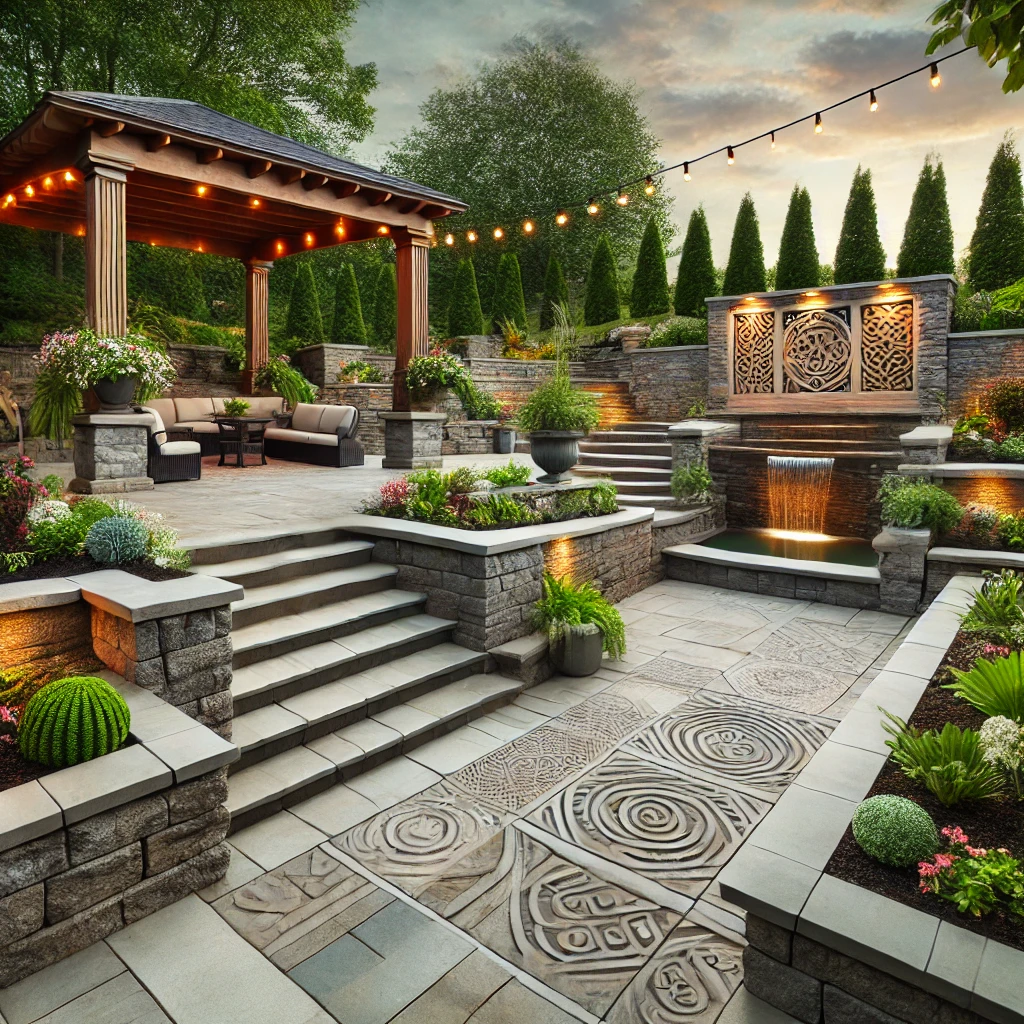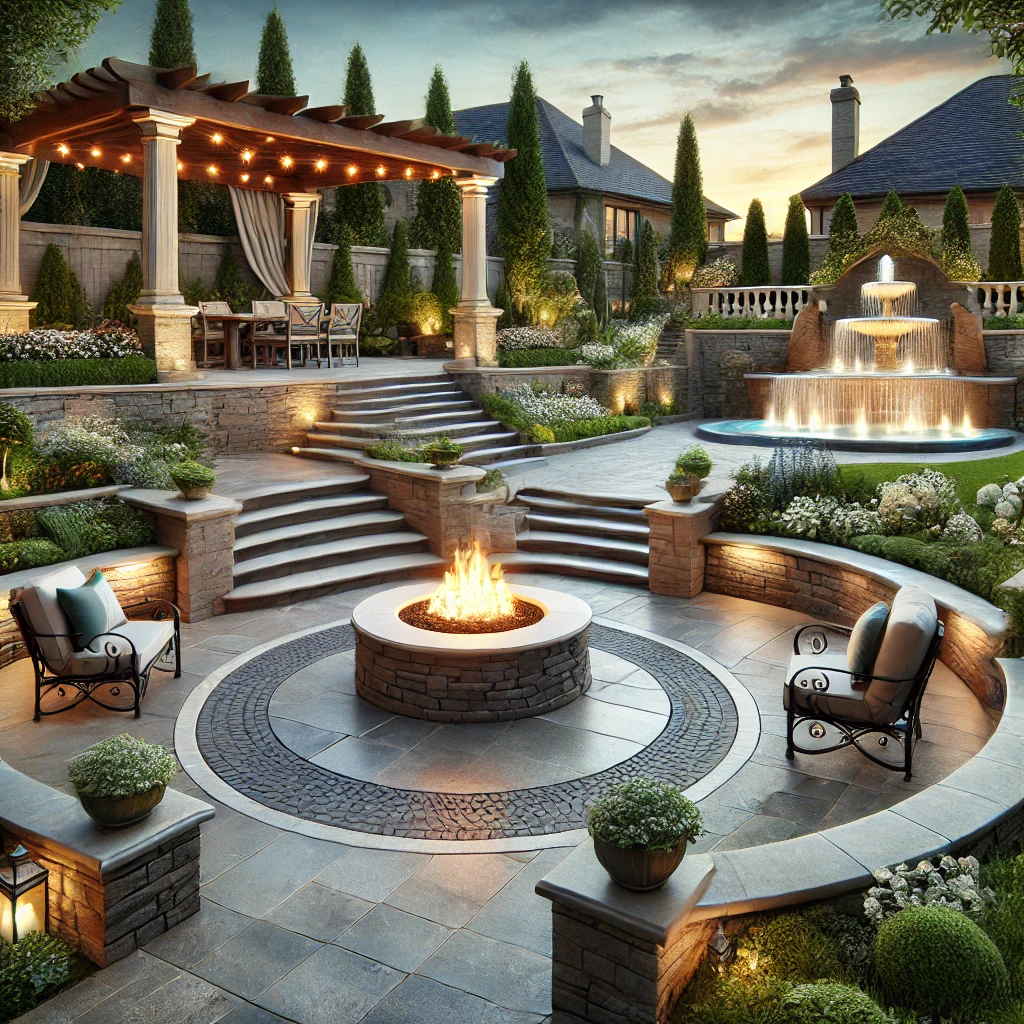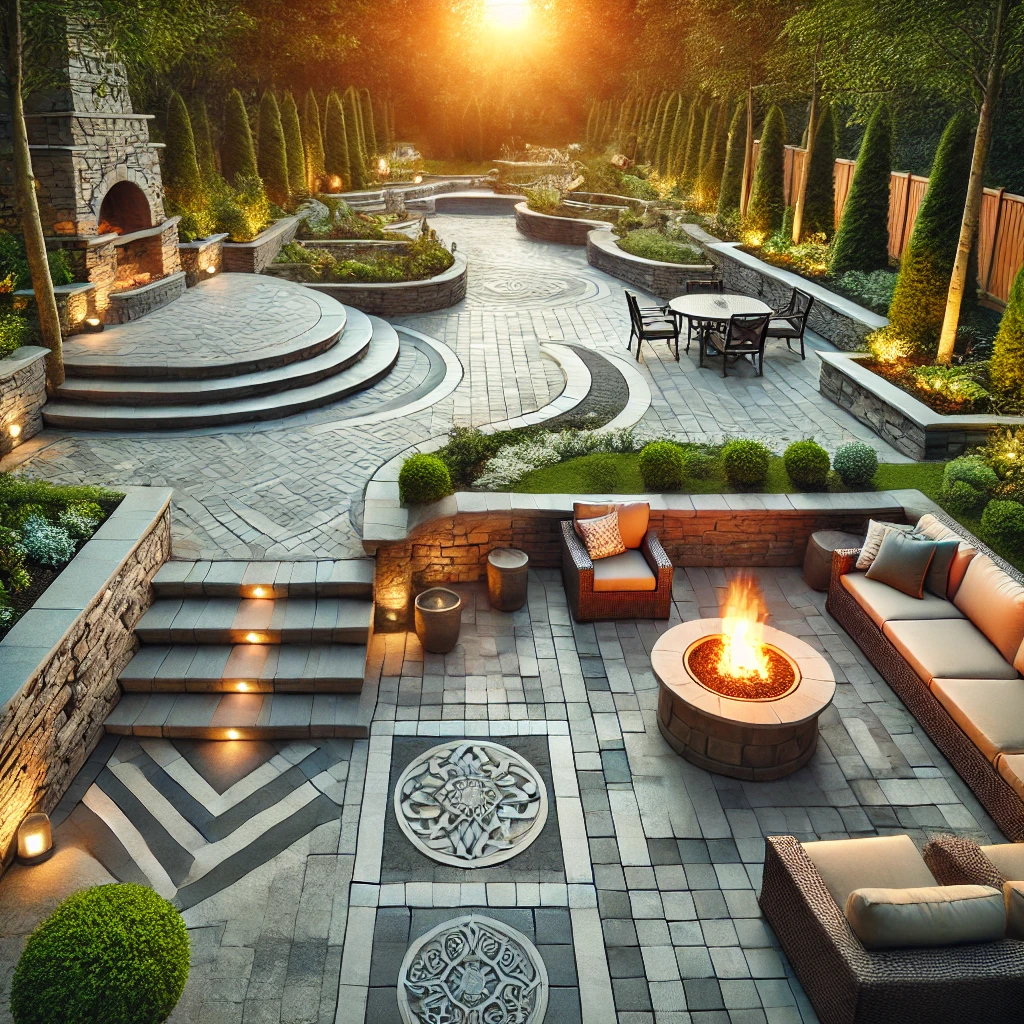What Is Hardscaping?
Hardscaping encompasses the non-living components of landscaping, providing both structure and functionality to outdoor spaces. Unlike plants or other softscape elements, hardscaping focuses on durable materials such as stone, concrete, wood, and metal. Common features include patios, which create solid foundations for outdoor seating or dining areas, and walkways that connect different sections of a yard while adding visual interest. Retaining walls serve both decorative and practical purposes, preventing soil erosion on sloped properties while defining garden beds. Outdoor kitchens are another example, blending utility and style to enhance outdoor living experiences. These features not only add value to a property but also create spaces that are designed to withstand the elements and require minimal upkeep.
Beyond their practicality, hardscaping elements contribute significantly to the aesthetics of outdoor areas. For instance, a stone walkway can create a rustic charm, while a concrete patio with sleek lines complements modern architectural styles. Retaining walls can be customized with materials like stacked stone or brick to match the surrounding environment. Additionally, hardscaping often incorporates lighting features, such as embedded pathway lights or illuminated walls, to extend usability into the evening. By balancing functionality with design, hardscaping transforms outdoor spaces into cohesive and visually appealing environments that cater to relaxation, entertainment, and everyday use.
Benefits of Hardscaping
Hardscaping offers a seamless blend of beauty and functionality, making it an essential component of any outdoor design. Features such as patios, walkways, and retaining walls enhance the visual appeal of a property, creating a polished and inviting look. This boost in curb appeal not only makes the space more enjoyable but also increases property value, making it a smart investment. Additionally, hardscaping provides practical solutions for common landscaping challenges. Retaining walls, for example, help prevent soil erosion on sloped terrains, while permeable pavers improve water drainage and reduce pooling. With its versatility and aesthetic advantages, hardscaping transforms ordinary spaces into stunning outdoor havens that cater to relaxation, entertainment, and everyday functionality.
Another significant benefit of hardscaping is its durability and low maintenance. Unlike softscaping elements such as plants or grass, which require constant care, hardscaped features are built to last. Materials like stone, concrete, and brick can withstand harsh weather conditions, from freezing winters to scorching summers, without losing their structural integrity. Proper installation ensures that these features remain stable and reliable over time. Additionally, maintenance typically involves simple tasks like occasional cleaning, resealing, or minor repairs, making hardscaping a cost-effective choice. By offering longevity and minimal upkeep, hardscaping delivers lasting value to homeowners while enhancing the usability and beauty of outdoor areas.
Common Hardscaping Materials
The materials used in hardscaping play a vital role in achieving both durability and aesthetic appeal. Natural stone is a top choice for many homeowners due to its timeless beauty and strength. Materials like flagstone, slate, and granite are commonly used for patios, walkways, and retaining walls, providing a unique texture and color variation that enhances any outdoor space. Brick is another popular option, prized for its classic charm and resilience. It works particularly well for pathways and driveways, offering a traditional look that complements a variety of landscape styles. Pavers, on the other hand, stand out for their versatility, available in a wide range of shapes, sizes, and colors, allowing for endless design possibilities in hardscaping projects.
Concrete is an ideal material for large-scale hardscaping projects due to its affordability and adaptability. Modern techniques such as stamping and staining allow concrete to mimic the appearance of more expensive materials like stone or wood, providing a cost-effective way to achieve high-end aesthetics. Its durability makes it suitable for high-traffic areas such as driveways and patios, while its ease of installation reduces project timelines. Additionally, recycled materials like crushed concrete or composite pavers are gaining popularity for their eco-friendliness, offering sustainable options without compromising quality. Choosing the right materials ensures that hardscaping features not only look great but also stand the test of time in outdoor environments.
Patios and Outdoor Living Spaces
Hardscaped patios are the cornerstone of outdoor living, creating functional and visually appealing spaces for relaxation and entertainment. Built using materials like natural stone, pavers, or concrete, these patios offer a durable surface that can withstand heavy use and harsh weather conditions. A well-designed patio provides a sturdy base for outdoor furniture, grills, or fire pits, enabling seamless outdoor cooking, dining, and socializing. One of the key advantages of hardscaped patios is their customizability; patterns like herringbone, basketweave, or random stone arrangements can be tailored to reflect your personal style. Whether it’s a small, intimate seating area or an expansive entertaining space, patios enhance the usability and aesthetics of your outdoor environment.
Hardscaped patios are also instrumental in maximizing the functionality of outdoor spaces by integrating multiple elements. For example, a patio can seamlessly connect to a walkway or serve as a transition between a home’s interior and the surrounding landscape. When combined with additional features like pergolas or retaining walls, patios help define outdoor living areas, creating distinct zones for lounging, dining, or recreational activities. Adding textures and finishes, such as stamped concrete or flagstone, further enhances their visual appeal. As the foundation of outdoor living spaces, hardscaped patios not only increase property value but also extend the usability of your outdoor areas throughout the year.

Walkways and Pathways
Walkways are an essential component of hardscaping, providing both functional and aesthetic benefits to any outdoor space. These paths serve as connectors, seamlessly linking different areas of a landscape, such as gardens, patios, and driveways, while guiding visitors through the property. Hardscaped walkways, made from materials like pavers or natural stone, offer a durable solution that stands up to foot traffic and weather conditions. Pavers, available in a variety of shapes and colors, can be arranged in intricate patterns to enhance the visual appeal of the space. Natural stone walkways, with their unique textures and tones, add elegance and blend harmoniously with surrounding greenery.
In addition to their aesthetic appeal, walkways enhance safety and functionality in outdoor spaces. By providing clear, stable surfaces, they ensure safe navigation, even during inclement weather. For instance, permeable pavers can reduce water pooling by allowing rain to seep through, making the paths safer and more environmentally friendly. Lighting fixtures, such as path lights or embedded LEDs, can be added to increase visibility and ambiance during the evening. Curved or winding pathways can be used to create a more organic, natural feel, while straight paths offer a clean and modern look.
Retaining Walls for Structural Support
Retaining walls are a crucial element of hardscaping, providing both structural integrity and aesthetic appeal to outdoor spaces. Designed to hold back soil on properties with uneven terrain, these walls prevent erosion and maintain the stability of the landscape. They are especially valuable in areas prone to heavy rain or water runoff, as they help direct water flow and reduce the risk of landslides or soil displacement. Retaining walls can be constructed from various materials, including concrete blocks, natural stone, and brick, each offering unique durability and design options. By creating level areas on sloped land, these walls make previously unusable spaces accessible for patios, gardens, or walkways, enhancing both functionality and visual harmony.
In addition to their structural benefits, retaining walls play a significant role in defining and beautifying landscapes. For instance, they can frame garden beds, creating a tiered effect that highlights different plants and flowers. Incorporating materials like stacked stone or textured concrete can add a decorative element, blending the walls seamlessly with the surrounding environment. Some retaining walls also double as seating areas or serve as borders for fire pits and outdoor kitchens, further enhancing their practicality. By combining stability with design, retaining walls transform challenging terrains into cohesive, attractive outdoor spaces that are both functional and visually appealing.
Driveways and Entrances
Driveways and entrances are vital components of hardscaping that significantly enhance both the functionality and curb appeal of a property. A well-designed hardscaped driveway serves as more than just a pathway for vehicles—it creates a polished first impression for visitors. Paver driveways, in particular, are a popular choice due to their durability and ability to support heavy loads, such as cars and trucks, without cracking. Unlike concrete or asphalt, pavers are resistant to freeze-thaw cycles, making them an excellent option for areas with fluctuating weather conditions. Additionally, they come in various colors, patterns, and shapes, allowing homeowners to customize the design to complement their home’s architecture and landscaping style.
Beyond durability and customization, hardscaped driveways offer practical advantages that make them a superior choice. Pavers are interlocking, which not only adds strength but also makes individual units easy to replace if damaged. Permeable pavers are another innovative option, allowing rainwater to filter through, reducing runoff and promoting eco-friendly drainage. To further enhance functionality, integrating features like edge restraints can prevent shifting over time, ensuring the driveway remains stable and intact. Whether paired with a decorative entrance walkway or bordered by lush landscaping, hardscaped driveways combine practicality and beauty, making them a standout feature that increases property value and usability.

Outdoor Kitchens and Fire Pits
Hardscaping plays a pivotal role in transforming outdoor spaces into fully functional extensions of your living area. Features like outdoor kitchens allow homeowners to cook, dine, and entertain in the open air, making gatherings more convenient and enjoyable. These kitchens can be customized with grills, countertops, sinks, and even refrigeration to suit individual needs. They not only add functionality but also enhance the aesthetics of your outdoor space, blending seamlessly with patios and seating areas. Fire pits, on the other hand, provide a cozy focal point for evenings, offering warmth and ambiance. Constructed from durable materials like stone or brick, fire pits are ideal for roasting marshmallows, sharing stories, or simply relaxing under the stars.
In addition to their entertainment value, outdoor kitchens and fire pits make outdoor spaces usable year-round. Fire pits, for example, extend the enjoyment of your yard into cooler months by providing a comfortable, heated gathering space. Outdoor kitchens reduce trips indoors by centralizing meal preparation and serving areas, making them a practical choice for large gatherings. Both features add value to a property, as they are highly desirable among potential buyers. By integrating these elements, hardscaping not only enhances the functionality of outdoor spaces but also creates inviting environments for leisure and socializing.
Hardscaping for Water Management
Hardscaping provides effective solutions for managing water flow and protecting outdoor spaces from damage caused by pooling and erosion. Permeable pavers are a popular choice for driveways, walkways, and patios, as they allow water to filter through the surface and into the ground below. This helps reduce runoff, alleviating stress on stormwater systems and minimizing the risk of flooding. Drainage channels are another critical feature, designed to collect and redirect water away from vulnerable areas such as foundations, gardens, or seating spaces. By incorporating these systems into hardscaping designs, homeowners can maintain the structural integrity of their properties while ensuring outdoor areas remain functional and safe during heavy rains.
Retaining walls also play a significant role in water management, especially on sloped properties. These walls help stabilize soil, preventing erosion that could lead to uneven surfaces or compromised landscaping. By strategically positioning retaining walls, water can be redirected to flow safely away from structures and into designated drainage areas. Additionally, integrating features such as French drains or dry creek beds enhances both functionality and visual appeal. These water management solutions not only protect the property but also ensure that hardscaping elements, like patios and pathways, remain intact and usable over time. Through thoughtful design, hardscaping effectively combines aesthetics with the practical need to manage water flow.
Design Tips for Hardscaping
Successful hardscaping is achieved by thoughtfully combining functionality with aesthetics to create cohesive outdoor spaces. Incorporating curves instead of straight lines adds a natural flow to pathways, patios, or retaining walls, making the design feel more organic and inviting. For instance, a winding stone walkway can guide visitors through a garden while creating visual interest. Varying textures, such as combining smooth pavers with rough-cut stones or stamped concrete, adds depth and dimension to the landscape. Complementary materials like natural stone and wood can be used together to achieve a harmonious balance that ties the hardscaping elements to the surrounding environment. These design strategies not only enhance usability but also ensure that the space reflects the homeowner’s personal style.
Color and scale are equally important considerations when designing hardscaping elements. Using materials that match or complement the architectural style of the home creates a unified look. For example, warm-toned pavers work well with rustic or Mediterranean-style homes, while sleek, neutral-colored concrete suits modern properties. Proper scaling ensures that hardscaping features, like patios or retaining walls, fit the proportions of the yard without overwhelming it. Additionally, integrating plants, lighting, and water features into the design softens the look of hardscaped areas, creating a perfect blend of structure and nature. By prioritizing both aesthetics and practicality, a well-designed hardscape can transform any outdoor area into a functional and visually stunning retreat.

Hardscaping Maintenance Tips
Proper maintenance is essential to preserve the durability and aesthetic appeal of hardscaping features. Regularly sweeping debris from patios, walkways, and driveways prevents dirt, leaves, and organic matter from accumulating, which can stain surfaces or encourage weed growth. Sealing materials such as pavers, stone, or concrete protects them from moisture, UV rays, and general wear and tear, extending their lifespan. Depending on the material, sealants should be reapplied every two to three years to maintain their protective properties. Addressing minor repairs promptly, such as replacing cracked pavers or reinforcing loose retaining wall blocks, prevents these issues from escalating into more costly damage, ensuring that your hardscaping remains both functional and visually appealing.
Seasonal maintenance is equally important for preserving hardscaping, especially in areas with extreme weather conditions. During winter, de-icing products should be chosen carefully, as some chemicals can damage pavers or concrete. Opting for sand or calcium-based de-icers minimizes this risk. In the spring, power washing can restore the vibrancy of hardscaped surfaces by removing built-up grime and algae. Regular inspections to identify potential issues, such as drainage problems or uneven surfaces, ensure that any necessary adjustments are made promptly. By incorporating these maintenance practices, homeowners can keep their hardscaping features in excellent condition, allowing them to enjoy their outdoor spaces for years to come.
Why Invest in Hardscaping?
Hardscaping offers a transformative way to enhance the functionality and beauty of outdoor spaces, creating areas ideal for relaxation, entertainment, and everyday enjoyment. Features like patios, walkways, and retaining walls provide durable, low-maintenance solutions that improve the usability of your property. For instance, a well-designed patio can serve as an extension of your indoor living space, perfect for outdoor dining or social gatherings. Hardscaping also brings visual appeal by integrating natural materials like stone or brick, complementing the surrounding landscape. These features provide structure and balance, making outdoor areas feel cohesive and inviting. With its blend of practicality and elegance, hardscaping enriches your outdoor lifestyle while adding lasting value to your home.
In addition to enhancing your outdoor experience, hardscaping is a smart financial investment that boosts property value. Homebuyers often view professionally installed hardscaping as a desirable feature, making your property more marketable. Retaining walls and walkways not only add visual interest but also address functional needs, such as preventing erosion or improving accessibility. The durability of materials like concrete, pavers, and stone ensures that hardscaping stands the test of time with minimal upkeep. By reducing the need for constant repairs or replacements, it offers long-term savings. Whether for personal enjoyment or increasing property appeal, investing in hardscaping is a decision that pays off in multiple ways.

